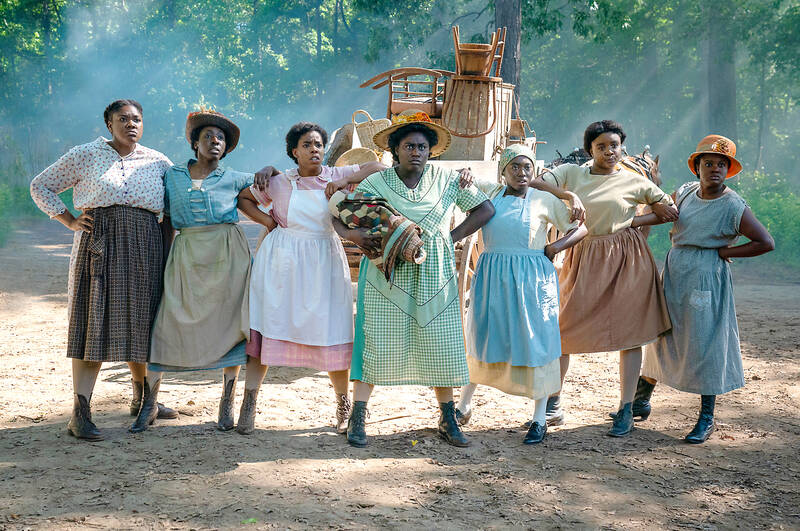It’s not a secret that Fantasia Barrino did not want to play Celie again. The American Idol winner hadn’t had the best time doing The Color Purple on Broadway.
The protagonist of Alice Walker’s Pulitzer Prize-winning novel tells her story of sexual, physical and psychological abuses in the early 20th century South in a series of letters to God. And it was a character she found it difficult to leave behind at the end of the day. Even the prospect of starring in her first major motion picture didn’t seem worth it.
But director Blitz Bazawule had a different vision: He wanted to give Celie an imagination. This Barrino found intriguing.

Photo: AP
“Once she understood the assignment, she quickly agreed,” Bazawule said in a recent interview.
Now, four decades after The Color Purple became a literary sensation and a Steven Spielberg film, the story is on the big screen again. This time it’s a grand, big budget Warner Bros musical starring Barrino, Taraji Henson, as the sultry singer Shug Avery, and Danielle Brooks, reprising her Broadway role as the strong-willed Sofia.
“I’m glad that I didn’t allow my fear of my past experience with Celie, because of where my life was at that time, to hinder me from doing something is great,” Barrino said. “I’m riding on a high right now.”

Photo: AP
Oprah Winfrey is one of several big-name producers on The Color Purple, alongside Spielberg, Quincy Jones and Scott Sanders. Winfrey got her acting break and first Oscar nomination playing Sofia in the 1985 adaptation, before helping Sanders turn it into a Broadway musical 20 years later.
Bazawule was not an obvious candidate to direct this film, however. The multi-hyphenate Ghanaian artist had received acclaim and recognition for co-directing Beyonce’s visual album Black is King. The only other film he had under his belt was the microbudget The Burial Of Kojo, which was made for less than US$100,000.
BLACK MUSIC HISTORY

Photo: AP
But he had ambitious ideas involving large scale musical numbers that would take audiences on a dazzling journey through the history of Black music in America, from gospel to blues to jazz. And, of course, Celie’s inner life. He wasn’t at all sure he would get it, but he knew the story he wanted to tell.
“I thought, if I could just find a way to show the audience how this Black woman from the rural South was able to imagine her way out of pain and trauma it will debunk a myth that is that people who have dealt with abusing trauma are docile and passive or waiting to be saved,” Bazawule said. “If we could just imbue in (Celie) that scale, then that’s the version that needed to exist. Thankfully they said yes.”
They would have to jump through some hoops, however, to secure the kind of budget (reportedly around US$100 million) that they needed to support the vision, including auditioning Henson, an Oscar-nominated actor, and Brooks, who already had a Tony nomination for her portrayal of Sofia.
“We were not the studio’s choices” Henson said. “I just felt some way about having to audition. I’m Academy Award nominated. I had just got finished singing on NBC’s Annie Live. But I checked my ego and I did it. I went in as Shug. I found a dress, had a flower in my hair and faux fur stole and I kicked the door down because I didn’t want them to ever second guess me again.”
For Brooks, it was a six-month process that had her doubting herself. A lot of the people involved in The Color Purple felt the exhaustion of both having to prove themselves yet again, but also wanting to rise to the challenge nonetheless because this film was worth it.
“This is a huge undertaking to be part of,” said Brooks. “This movie is about legacy and it’s what I’ve been calling a cinematic heirloom.”
Her Broadway production was very minimalist and stripped down, so to be on location in Georgia, around Macon, Savannah, Atlanta and the small town of Grantville, was revelatory.
“My world really opened up because I got to use all of my senses,” Brooks said. “I got to explore all of Sofia because now I have a juke joint and I have a dinner table. I have a house. We had a white mob attacking me.”
The juke joint was a real set that required a real swamp to be dredged, where they’d stage Shug’s showstopper, Push Da Button.
“It’s probably the perfect confluence of my amazing technical and creative teams,” Bazawule said.
The film gives a new boldness to Celie and Shug’s relationship with one another and more dimensions to the male characters, including Colman Domingo’s Mister.
And all carry the weight of responsibility not only to the material and its predecessors, but also to future films made with primarily Black casts at this level.
“It’s not the first time I have been in a production of this scale but what matters to me is that it’s a Black production and it’s a production with Black producer, a Black director, predominately Black cast,” Henson said. “It’s like usually we’re supposed to make a dollar out of 15 cents. And after 20+ in the game, it’s like finally the studio trusted us to deliver.”

May 6 to May 12 Those who follow the Chinese-language news may have noticed the usage of the term zhuge (豬哥, literally ‘pig brother,’ a male pig raised for breeding purposes) in reports concerning the ongoing #Metoo scandal in the entertainment industry. The term’s modern connotations can range from womanizer or lecher to sexual predator, but it once referred to an important rural trade. Until the 1970s, it was a common sight to see a breeder herding a single “zhuge” down a rustic path with a bamboo whip, often traveling large distances over rugged terrain to service local families. Not only

By far the most jarring of the new appointments for the incoming administration is that of Tseng Wen-tsan (鄭文燦) to head the Straits Exchange Foundation (SEF). That is a huge demotion for one of the most powerful figures in the Democratic Progressive Party (DPP). Tseng has one of the most impressive resumes in the party. He was very active during the Wild Lily Movement and his generation is now the one taking power. He has served in many of the requisite government, party and elected positions to build out a solid political profile. Elected as mayor of Taoyuan as part of the

Moritz Mieg, 22, lay face down in the rubble, the ground shaking violently beneath him. Boulders crashed down around him, some stones hitting his back. “I just hoped that it would be one big hit and over, because I did not want to be hit nearly to death and then have to slowly die,” the student from Germany tells Taipei Times. MORNING WALK Early on April 3, Mieg set out on a scenic hike through Taroko Gorge in Hualien County (花蓮). It was a fine day for it. Little did he know that the complex intersection of tectonic plates Taiwan sits

When picturing Tainan, what typically comes to mind is charming alleyways, Japanese architecture and world-class cuisine. But look beyond the fray, through stained glass windows and sliding bookcases, and there exists a thriving speakeasy subculture, where innovative mixologists ply their trade, serving exquisite concoctions and unique flavor profiles to rival any city in Taiwan. Speakeasies hail from the prohibition era of 1920s America. When alcohol was outlawed, people took their business to hidden establishments; requiring patrons to use hushed tones — speak easy — to conceal their illegal activities. Nowadays legal, speakeasy bars are simply hidden bars, often found behind bookcases